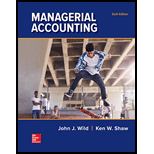
Concept explainers
Concept introduction:
A trial balance is a book-keeping worksheet, which is prepared at the end of a specified period to record ending balances of all ledger accounts in either debit or credit column. In other words, we can say that a book-keeping worksheet, which is prepared to check the mathematical accuracy of the accounting recording is known as trial balance.
Requirement 1:
A trial balance as of the end of May.
Concept introduction:
Trial balance:
A trial balance is a book-keeping worksheet, which is prepared at the end of a specified period to record ending balances of all ledger accounts in either debit or credit column. In other words, we can say that a book-keeping worksheet, which is prepared to check the mathematical accuracy of the accounting recording is known as trial balance.
Requirement 2:
A cash T-account.
Want to see the full answer?
Check out a sample textbook solution
Chapter D Solutions
Managerial Accounting
- I am trying to find the accurate solution to this general accounting problem with appropriate explanations.arrow_forwardI need help finding the accurate solution to this general accounting problem with valid methods.arrow_forwardI am looking for help with this general accounting question using proper accounting standards.arrow_forward
 Individual Income TaxesAccountingISBN:9780357109731Author:HoffmanPublisher:CENGAGE LEARNING - CONSIGNMENT
Individual Income TaxesAccountingISBN:9780357109731Author:HoffmanPublisher:CENGAGE LEARNING - CONSIGNMENT


